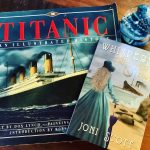Tag Archives for " Whispers through Time "

The novel came into being in the 18th century as a construction defined by a slow unfolding of characters and plot with ensuing dramas, misunderstandings and entanglement of the characters that ends with a final resolution of either happily ever after or tragedy. The term novel is a contraction of the ‘novella’ (meaning ‘new, innovative’) an Italian word defining short stories of light and entertaining nature, an antidote to the epic poems of earlier days. It is interesting that the contracted form the novel now denotes a larger serving of prose than the novella. Early Novels usually took a narrative form and proceeded to tell the tale in chronological order. Literary scholars date the novel in its earliest form to Samuel Johnson’s Pamela of 1740 though experimental forms existed back to the epic Morte d’Arthur by Sir Thomas Malory in 1485. Such early work did not concentrate on the individual but employed stereotypical characters to drive the narrative with accompanying moral lessons for the reader. These ‘novels’ were long winded, lacked humour and preached moral rectitude to their audience. They are hard for the modern reader to digest.
In 1818 though, Mary Shelley a young woman of amazing talent possessing a vivid imagination wrote the Gothic novel called Frankenstein. The tale started out as a short story prompted by a late-night dare by fireside companions to each write ghost stories. Her companions were her husband Percy Bysshe Shelley and Lord Byron both influential Romantic poets. But Mary’s story aced theirs and its character Frankenstein became legendary. Many do not realise that Frankenstein was the doctor who created the manufactured monster not the name of the monster himself. Apart from its unique character and plot, Frankenstein has a deep message about life, death and man versus Nature. The work is seen as the precursor to science fiction, an unknown genre at the time but one French author, Jules Verne would later embrace in his fantastical stories.
Jumping forward to a familiar name and a change in the style of the novel genre we come to the works of Jane Austen (1775-1817). Her six novels, many now adapted to film, are refreshing in their strong female characters and depiction of real life on the home front. Elizabeth Bennett and Darcy are well known characters even to non-Austen fans. Though the stories lack rollicking adventure and Gothic tragedy, really nothing more than elopements and love triangles, they excel in irony, humour and accurate observation of real people. Austen’s character driven novels paved the way for The Bronte sisters who emerged as a brilliant trio of writers some thirty years later. These young women who all died young, Anne at 29, Emily at 30 and Charlotte at 39, never travelled beyond Yorkshire yet penned sweeping passionate novels that startled the reading public at the time. Even today, Jane Eyre by Charlotte Bronte and Wuthering Heights by Emily, rate in the top romance novels of all time. These works challenge all the previous overly polite fiction populated by swooning virgins and swashbuckling heroes.
Enter Dickens in the 19th century who creates great characters but tends towards long winded narration and social commentary akin to the Romanticism of poets like William Blake and Wordsworth. Another notable female author, Mary Ann Evans (1819-1880) wrote under the pen name of George Eliot and created extraordinary moral conflicts for her characters in the novels, Mill on the Floss and Silas Marner. Her work shows great intellect and a mastery of the tragic element. This paves the way for Thomas Hardy and his tragic novels of which he wrote many. He concentrated his stories in Wessex, a place term he invented. His tragedies are all set in the countryside and mostly focus on the poor and hard done by people of the working class. They present a strong discourse of man battling Fate and are almost reminiscent of the great tragedies of Shakespeare. The Return of the Native, The Mayor of Casterbridge and especially Tess of the D’Urbervilles leave a lasting impact. The latter affected me so much as a teenager that I named my daughter Tess!

Even after its sinking on an icy cold April night long ago in 1912, the Titanic has proved to be an unsinkable story of human tragedy.
Indeed, The RMS Titanic lives on as a cautionary tale of what can go wrong when ego and monetary concerns overpower responsibility and safety. This tragic tale endlessly fascinates us despite the ship’s loss to the icy depths of the Atlantic over a century ago. The ill-fated Titanic is the subject of many books such as the definitive A Night to Remember by Walter Lord (1956) and Titanic, An Illustrated History by Don Lynch (1992). It features in Stephen Weir’s book, History’s Worst Decisions and is even the inspiration for a children’s book called Polar, the Titanic Bear, about the actual teddy bear of a little boy who survived the sinking. Speaking of which, there is one last book I just have to mention that is also a fascinating read. Shadow of the Titanic follows the lives of the survivors of that terrible night. Interestingly, most of them had sad lives and many died young and even quite soon after the event. The little boy who owned the teddy bear died in a family car crash within a year and is just one example of the long shadow that the Titanic cast over people’s lives. Some folk never recovered from family losses while others bore survivor’s guilt that prevented their happiness.
Yes, the Titanic story is one that keeps on giving. There is so much to fascinate, so many lessons about human nature to appreciate.
As a long-time enthusiast of all things Victorian, the story interested me long before the blockbuster 1997 Titanic film produced by James Cameron. I had already watched the earlier film starring Barbara Stanwick and seen and read films and books where the Titanic had sailed in, creating a setting for many tragic storylines. I confess to Titanic jigsaws and scale models as well.
But all the tragedy could have been averted if someone like Bruce Ismay, Captain Smith or the ship builder, Thomas Andrew had read another book by a little-known author named Morgan Robertson. In 1898, he wrote a novel about a transatlantic liner loaded with the rich and famous that hit an iceberg near Newfoundland at similar co-ordinates. The ship, eerily called the Titan had very similar specifications to the actual Titanic.
If only someone had read this book, aptly titled Futility.
It is telling of human nature that we are drawn to details of tragedies. Perhaps it is because there is so much to take away and reflect on. The factors that caused the tragedy are themselves endlessly fascinating. In this instance there were a myriad of fateful errors both human and natural. Titanic was steaming ahead in an ill-fated race with Time itself. Captain, Edward Smith confidently ordered her throttled into full steam so she could arrive in New York ahead of schedule. He along with Bruce Ismay, director of White Star Line wanted to showcase her capabilities as the biggest ship ever to sail the seas. It was Smith’s last commission at sea so this would be a fitting end to his career. A timely six day crossing of the Atlantic was important for both men.
Neither man seemed concerned by reported ice warnings in the ocean ahead, nor overly mindful of their responsibility to the cargo of 2240passengers, despite the paucity of lifeboats. The Titanic had everything anyone could want on board a ship except lifeboats. Even at two thirds capacity of its possible number of passengers there were only enough for 1178 people, leaving 1023 others stranded. That is only too if the lifeboats were fully loaded which was definitely not the case. Many that could take 65 people, left with less than twenty aboard. Some of these fortunate were extremely wealthy and influential women along with children and even first-class men. Most second and third-class passengers went down with the ship.
If it were not for the speed, the inattention to ice, the lowered bulkheads, the limited life-boats, the missing binoculars on the watch deck, the steel, the pop rivets, the last-minute attempt to swerve around the iceberg…. So may ‘ifs, so many factors that coalesced to cause tragedy.
Then apart from the ship’s construction, the speed and human factors there was the bad luck that the only nearby ship, the Californian turned off its telegram service and retired all staff to bed. Even after sighting a flare rocket. ‘We thought it was a just a party,’ the captain claimed in defense. Words that went down in history like those of Captain Smith. ‘I cannot imagine any condition which would cause a ship to founder. Modern shipbuilding has gone beyond that.’
There is so much more I could write about this Titanic subject. Many have. Instead, I chose some human-interest snippets to include in two chapters of my historical fiction novel, Whispers through Time. This book is based on my grandparent’s journey from London to Australia on a steamer ship, the Rangatira in June 1912, just months after the sinking of the ill-fated liner. The tragedy was recent news. It is a wonder they still travelled into the ice infested waters of the southern oceans. But they did and even retraced the journey two years later through U boat infested waters to return to England as grandfather was called into military service. He was still part of the British Army, having served already in the Boer Wars when he was just sixteen. Their story continues on in the sequel released this year, Time, Heal my Heart.
Follow my history blogs on https://joniscottauthor.com
Australian readers check out Author Academy Bookstore, https://authoracademybookstore.com.au